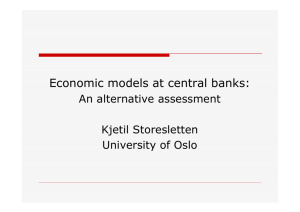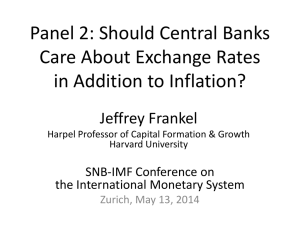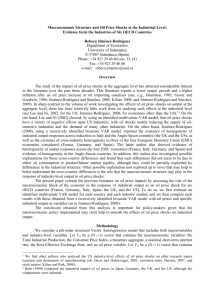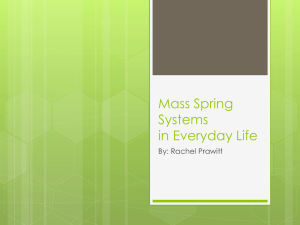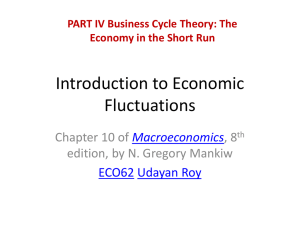Discussion of John Y. Campbell, Stefano Giglio, and Christopher Polk
advertisement
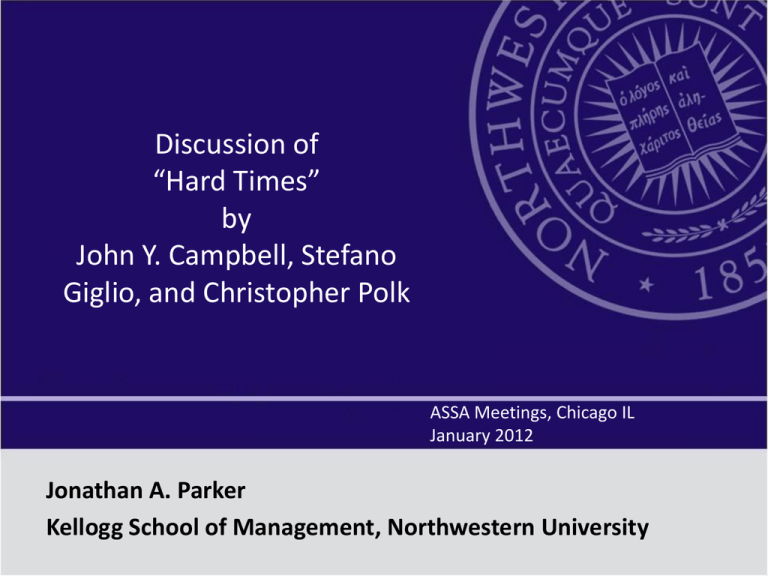
Discussion of “Hard Times” by John Y. Campbell, Stefano Giglio, and Christopher Polk ASSA Meetings, Chicago IL January 2012 Jonathan A. Parker Kellogg School of Management, Northwestern University The idea: use historical relation between assets returns and subsequent cash flow and discount rate changes to infer whether the market expects a given market downturn to be followed by higher future discount rates or lower future cash flows Outline 1. 2. 3. 4. The method The data The findings Thoughts on the big question: interpretation 1. The method Or what the Dickens is going on? Step 1: Campbell Shiller (1988): assume the Dividend-Price ratio is stationary Dt Pt Any deviations in ratio must lead to future changes in dividends or prices (returns) Log-linearize: Implies that an unexpected return leads to a change in expected future dividends or returns Shocks to stream of cash flows (CF) and discount rates (DR) • Can calculate NCF and NDR from any forecasting model, use a VAR • Applies to any asset with stationary dividendprice ratio (is this true of the market?) Optional: impose some restrictions on returns implied by optimization of • a representative agent • with KPEZW utility • who faces only risks spanned by the two shocks (e.g. no uninsurable labor income, no private equity, etc.) • and all returns are all jointly lognormal • and homoskedastic While all are violations of reality, they are common modeling assumptions and some models with these features can fit may asset pricing facts with heteroskedasticity – Time-variation in risk is large for the focal episodes, 2008 in particular – We are referred to Campbell, Giglio, Polk, and Turley (2011) for time-varying volatilities Great Expectations of returns: Expected returns determines by exposure to cash flow shocks and discount rate shocks • Decomposition of expected return as due to two different exposures – The more exposed to good cash flow news, the higher expected return and the lower price – The more exposed to good discount rate news (low rates in future) the higher expected return and the lower price • Beta’s can be calculated, used in regression with average returns (actually use as moment restrictions) • Restriction: Cross-section has expected returns times more sensitive to CF than DR 2. Data For VAR 1. Excess log return on the CRSP value-weighted index 2. Log ratio of the S&P 500's price to the S&P 500's ten-year moving average of earnings 3. Yield difference between the log yield on the ten-year US constant-maturity bond and the log yield on the threemonth US treasury 4. Difference in the log book-to-market ratios of small value and small growth stocks 5. Yield spread in percentage points between the log yield on Moody's BAA and AAA bonds For expected returns/cross-section: 6 portfolios measuring size (ME) and value (BE/ME) premia 3. Findings Time-Smoothed shocks to CF (left) and DR (right) unrestricted model (top) and restricted model (bottom) Note: shocks negatively correlated (-0.070 unrest. -0.577 rest.) Cash-Flow shocks - Positive in recovery from G.D. - Negative in 1980’s and 1990’s - Positive in 2000’s Suggest one-sided smoother Discount rate shocks - Negative on market in G.D. - Positive in end of G.D. and WWII - Negative in early 1950’s & 1970’s - Positive in 1990’s internet boom It was the best of times, it was the worst of times . . . Shaded areas: NBER recessions Dark lines: market peaks with two year-windows Hard times: cash flow news followed by disc rate (G.D. and 1937) Pure sentiment: discount rate news (end of WW II and 1961) Other: Sentiment followed by cash flow/ NBER recession 4. Interpretation/thoughts Not primitive shocks – and not claimed to be - Why are times with high future discount rates not hard times? - They are times when output today has become scarce relative to the future - If because of increased future cash flow, these are good times, if because of increased risk or anxiety, these are bad times - What about credit in the “credit episode”? - Institutional view: lowered constraints, low market risk aversion - Are there enough similar episodes to identify market expectations? - Is it reasonable to use the restricted model? - Is the paper proscriptive for a long-horizon, attentive, CRRA investor? - The decomposition is useful for refining models - My interest: identify structural shocks that map into each type of reduced form shock and generate facts for models - E.g. does a monetary policy shock hit mostly cash flow or discount rates? 5. Conclusion Old literature: are all business cycles alike? Answer: lots of similar comovement, but some differences This paper starts to build similar facts for stock market cycles, crashes in particular Main finding: different market declines in US history have had quite different implications for future cash flows that are visible in contemporaneous asset prices

